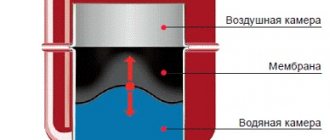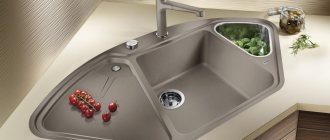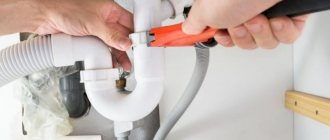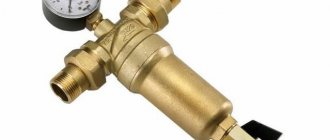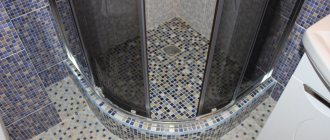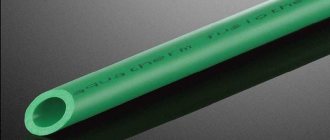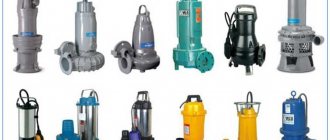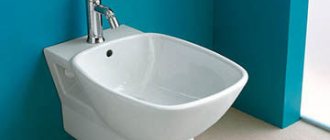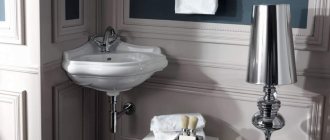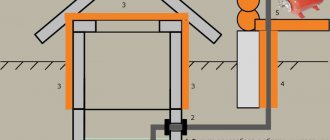/Repair/Plumbing/
Installing a siphon in the kitchen is a very simple task that takes a maximum of 20 minutes and requires nothing more than a screwdriver. Especially if you need to install a new trap on a new sink that has not yet been installed. But if you need to replace an old device, then the difficulty will lie mainly in dismantling, rather than installation. Therefore, there is little point in calling a plumber and spending money on it.
There are different siphons for the kitchen - for regular and double sinks, with the ability to connect to a washing machine or dishwasher, with or without an overflow, made of metal or plastic, like a bottle or pipe. But they are all installed approximately according to the same principle, so we have written one step-by-step instruction with an addition - for installing a siphon with an overflow and installing a double siphon for a two-bowl sink.
And, of course, all siphons have one repurpose - not to allow gases, that is, odors from the sewer, to pass through using a water seal formed in the sump, and also to retain food debris, garbage, and small objects in it.
In this instruction, we will look at the method of installing a regular plastic bottle-type siphon, which most often complements the kitchen sink, because it is very easy to clean.
Addition - installation of a siphon with overflow
If your sink has an overflow, then installing the siphon will be carried out in approximately the same sequence as described above. Except that at the stage of assembling the device (see step No. 2), you will need to additionally assemble the overflow itself, as shown in the photo below. The principle of connecting the overflow to the outlet of the pipe is exactly the same as in the previous instructions - first we put on the nut, then the ring gasket with the blunt end to the overflow, then we insert the overflow into the outlet and tighten the nut.
Now you need to connect the sink with the overflow using a screw and a screwdriver. Then we proceed according to the instructions in steps No. 3 and No. 4.
Device and purpose
Water seal diagram
The siphon not only removes dirty water, but it also has another purpose. Thanks to its special design, it retains large debris, preventing it from entering the sewer pipe and therefore reducing the likelihood of clogging. But the main function of this device is to form a water seal, which serves to protect the room from harmful and unpleasant odors.
It deserves special attention that for a bathroom it is advisable to use a siphon, which has the form of a pipe with a special S- or U-shaped bend to form a water plug. For a kitchen sink, it has a more complex design, since it is mainly designed to accumulate debris and then clean it.
Sink siphon
Siphons for kitchen sinks have the following design:
- Pipe for connection to the sink. The structure is fixed to the sink filter grid using a nut.
- Pipe for connecting the overflow. Used in cases where it is possible to connect the drain of a washing machine or dishwasher.
- The reservoir or glass is the main part of the structure. A water seal is formed inside the tank, and thanks to the volumetric lid, accumulated debris can be quickly removed.
- The outlet pipe is designed to connect to a sewer pipe to drain dirty water.
Equipment
Siphon design
Above is a diagram showing the location of the parts. But whatever the design of the siphon, each of them has a small bend or a small reservoir, due to which some of the water is retained in the pipe. This creates a water seal that prevents noise and unpleasant odors from entering the room.
For the manufacture of this device, plastic (propylene, polyethylene, PVC) or chrome-plated metal is most often used. A metal product, in addition to being reliable, also looks more attractive and solid. But over time, the metal oxidizes even despite the galvanic coating. For this reason, in everyday life it would be preferable to use plastic appliances that do not corrode during operation and are easily cleaned of dirt, as well as being more affordable.
Siphons
Plastic siphon contents:
- Connection pipe for connecting to the sink. Using a nut, the device is fixed to the sink filter grid.
- Outlet pipe. It is connected to a sewer pipe to drain dirty water.
- The glass or reservoir is the main part of the structure. A water seal is formed in the glass. There is a lid at the bottom, which is designed to quickly remove accumulated debris.
- Outlet pipe. Some models have an added outlet through which the drain of the washing machine or dishwasher is connected.
- The protective grille, installed in the drain hole of the sink, prevents large waste from entering the sewer.
- A rubber stopper designed to plug a drain hole. Cheap devices do not have such a plug.
- Rubber gasket to be placed between the outlet and the sink. The thickness of the gasket can be 3–5 mm.
- Rubber gasket under the exhaust pipe.
- Plastic nut for the exhaust pipe.
- Connecting screw made of copper or stainless steel Ø 6–8 mm. It is noteworthy that cheap models come complete with metal screws with a thin coating of nickel or chromium. Screws made of such material are unreliable, quickly rust and break down. You can choose a device with a high-quality magnet using a small magnet that tests metal. Stainless steel screws will not be magnetic.
- Nut made of brass, copper or stainless steel. In this case, an iron nut will not work, as it will not last even more than a year due to corrosion.
- The body of the product is in the form of an elbow or a bottle.
- Plastic coupling nut.
- Two conical rubber or plastic gaskets.
- Sewer outlet.
- Nut for fastening the plastic adapter.
- A glass or siphon lid - for the strength of the device.
- Large rubber gasket for a tight fit of the device cover to the body.
- Sewer outlet - standard plastic or corrugated pipe, plastic pipe, flexible hose.
Siphon with overflow
There may also be a siphon with an overflow, which is installed on sinks that are designed with an overflow.
Bottle type siphon
A bottle-type device, despite its more complex design, is more popular in everyday life than a pipe siphon, as it is compact and easy to maintain. And if valuable items accidentally fall into the drain, they can be easily removed by unscrewing the bottom cover.
Assembly
Siphon in package
Installation of a siphon can be performed by every home owner. But although the assembly and installation of the device is relatively simple, nevertheless, this process requires a responsible approach. Otherwise, negligence will lead to leakage and the appearance of unpleasant odors from the drain hole into the room.
When purchasing, you need to make sure that the rubber gaskets are of good quality. In the presence of the seller, the assembled device is disassembled to make sure that the fastenings are reliable and all components are available. You should not ignore possible defects (chips, cracks, burrs), as they can contribute to leaks.
When choosing a kitchen siphon, you should pay attention to some points:
- The diameter of the sink hole must match the diameter of the filter grid that comes with the device.
- Connecting other plumbing fixtures. If you need to connect a washing machine or dishwasher that requires water to be drained into a sewer pipe, you should purchase a device with an additional outlet for connecting the drain hose.
- Dimensions of the product: For installation under the sink, free space is required. Otherwise, you need to purchase a small device.
- Diameter of the sewer hole. The pipe that serves as the connection between the outlet pipe and the sewer must be of the appropriate diameter. In the case of a smaller diameter, a rubber adapter may be required, but the diameter should not be larger than the sewer hole.
- Aesthetic solution. If the device is externally closed or hidden in a kitchen cabinet, then it does not matter what material it is made of. And for an open arrangement, it would be appropriate to purchase a chrome-plated product, although its cost is more expensive.
- Product cost. The quality of a device does not always depend on its cost. It is quite natural that you can use a metal siphon in the kitchen much longer than a plastic one. But, in principle, a plastic product can last a very long time. Therefore, the difference in price is due to the external component rather than functionality.
Material of manufacture
There are several materials from which siphons are made:
- chrome plated brass;
- propylene/polyisopropylene;
- PVC.
It is absolutely clear that the most expensive siphons will be those made of brass. However, it is worth noting that the main advantage of such siphons is their aesthetic appearance. Speaking about the technical characteristics of brass siphons, it is worth saying that they are inferior to plastic ones even in matters of strength. One awkward blow can cause irreparable damage to a brass product, while a plastic product can only get away with a dent.
The most budget-friendly material is PVC, but its service life is about 6 years, while a propylene product can last 10 years, but is somewhat more expensive. Another advantage of a propylene product is that it tolerates cleaning well using chemicals and cables.
How to connect a bathtub to the sewer
After the bathtub has been purchased and delivered to the bathroom intended for it, it must be installed correctly, taking into account the configuration of the room, existing pipes, utilities and design decisions of the owners.
Scheme of connecting the toilet to the sewer.
Having decided on its general location, which will subsequently determine the connection of water and sewerage pipes, it is necessary to adjust its stability, height and slope. Bathtubs can be installed on legs, stands or other supports. Moreover, they must withstand a mechanical load of at least 100 kg applied to the long side of the bath anywhere vertically downward, and be stable.
In addition, the height of the bath should be at least 145 mm from the floor to the bowl outlet. This is done so that the necessary height difference can be created in the area between the drain hole and the connection point to the sewer. If there is no height difference or it is insufficient, the water from the bowl will come out poorly and possibly stagnate. In addition, the resulting space between the floor and the bottom of the bowl will allow for relatively free access to the drain for possible revision or replacement of the siphon.
After installing the bathtub on the above supports or supports, make test measurements of the resulting heights: a) from the clean floor to the outlet, b) from the clean floor to the top of the side of the bowl at four points in its corners. The latest data should not differ from each other by more than 4 mm. Next, set the slope of the bottom of the bath towards the outlet through which the bath is connected to the sewer. This slope is set at the rate of 2 cm per 1 m of bathtub length. After the work on its installation and adjustment is completed and the bowl is finally fixed vertically and horizontally, you can begin connecting its drain to the sewer.
Preparatory work
Before purchasing a siphon, you must measure the diameter of the old spout in advance so as not to make a mistake with the purchase. A new one should be purchased with the same fit size. If a suitable siphon is not available, it is recommended to purchase an additional adapter sleeve. The sealing collar should also be purchased together with the siphon in order to immediately check how well it fits with it. Large burrs on the side of the spout indicate poor quality of the product, so you should not take a siphon of this quality - the existing burrs will not allow the cuff to fit tightly on the product.
Removing the old siphon
The preparatory work is quite simple. It is necessary to remove the old siphon and clean the sewer pipe. However, you should not clean it until it shines, since the cuff is designed to fit on a rough surface. Lastly, it is recommended to lay out the equipment and the necessary tools in front of you, so as not to make unnecessary movements in search of the required material.
Step-by-step instruction
Changing the siphon under the sink is quite simple, but at the same time quite difficult. The replacement process itself does not require special skills, while finding the right siphon can take a long time, especially if the sink has two compartments or other difficulties. In addition, new apartments today are equipped with several risers, as a result of which the sewer pipe is located on the wall, which allows it to go directly into the riser. The standard algorithm for installation is as follows:
- First of all, you need to check the fit of the drain grate. It is very important that the stamping is a normal size as a small stamping will cause a puddle to form. If necessary, you can place the grille on a sealant without resorting to a gasket;
- The next step is to install the cuff in the sewer pipe. The cuff must be lubricated with sealant and ensure that the pipe is dry;
- Next, you should carefully check the body threads for the condition of their mating surfaces.
All burrs must be removed with a sharp knife. You should also cut chamfers of 0.5-1 mm in size; Assembling a classic siphon - The outlet end for draining, if necessary, should be adjusted to size, then connected to the cuff and the structure secured. Fastening can be done using a clamp. It is important to remember that the threaded end of the pipe must face the siphon body;
- in the case when the spout is directed downwards, a square is attached to the sealant to the pipe, more precisely, its upper end;
- then the drain grid should be fastened, while the gasket should be left aside for now;
- it is necessary to place an o-ring gasket in the groove of the plug, then lubricate it with sealant and screw it on;
- For the bottle design, it is necessary to install a valve, which will be located in the outlet pipe. It is important that the damper is able to open outwards;
- Next, the bottle mold is attached to the outlet pipe. To do this, it is necessary to equip the pipe with a cone-shaped gasket, with the narrow end facing the bottle. Then we start the bottle and tighten the side nut, but not tightly;
- We move on to the upper pipe, into the groove of which the gasket should be placed, again using sealant. After this, you need to bring the bottle to the drain pipe and tighten the structure using the top nut, but not tightly;
- Next, tighten the nuts, slightly shaking the siphon body.
This instruction describes in detail how to change the siphon in a sink or kitchen sink. However, this algorithm of actions will not help to replace the siphon under the bathtub, since the design is slightly different. Based on how correctly the actions were performed and how high-quality the design was purchased, the service life and performance characteristics of the siphon will depend.
